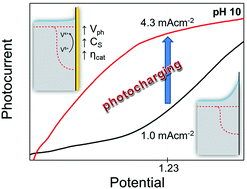Near-complete suppression of surface losses and total internal quantum efficiency in BiVO4 photoanodes†
Abstract
Bismuth vanadate (BiVO4) is one of the most efficient light absorbing metal oxides for solar water splitting. BiVO4 photoanodes immersed in an electrolyte in an open circuit configuration and exposed to simulated solar illumination for prolonged time achieve superior photoelectrochemical (PEC) activity. This photocharging (PC) effect is capable of almost completely overcoming the surface and bulk limitations of BiVO4. Herein we show that alkaline conditions favor the PC effect; specifically BiVO4 photoanodes subjected to PC treatment at pH 10 achieve a record high photocurrent for undoped and uncatalyzed BiVO4 of 4.3 mA cm−2 @ 1.23 VRHE, an outstandingly low onset potential of 0.25 VRHE, and a very steep photocurrent onset. Alkaline conditions also facilitate excellent external and internal quantum efficiencies of 75 and 95% respectively (average in the 440 nm > λ > 330 nm range). Moreover, impedance spectroscopy and in situ XAS study suggest that electronic, structural and chemical properties of the bulk of these films remain unchanged during the PC treatment. However, appreciable changes in the surface-related properties take place. Ultimately, our results indicate that the improved activity of PC-BiVO4 is enhanced by surface reaction pathways of the semiconductor–liquid junction, which is directly correlated with the electrochemical environment in which it is modified.



 Please wait while we load your content...
Please wait while we load your content...